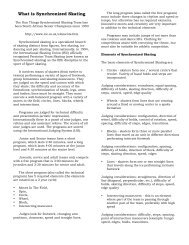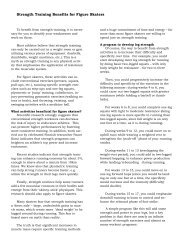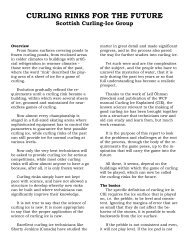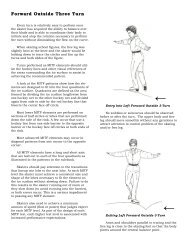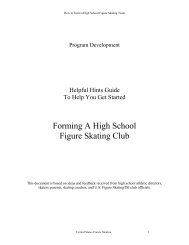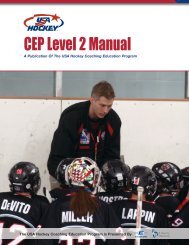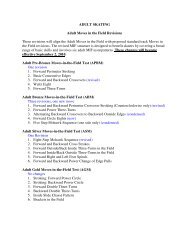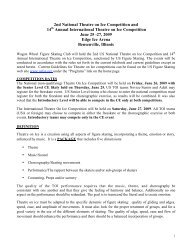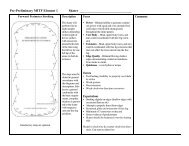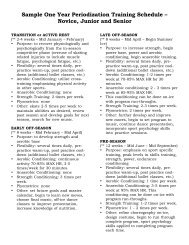CEP Level 3 Manual - Rushmore Hockey Association
CEP Level 3 Manual - Rushmore Hockey Association
CEP Level 3 Manual - Rushmore Hockey Association
Create successful ePaper yourself
Turn your PDF publications into a flip-book with our unique Google optimized e-Paper software.
T A B L E O F C O N T E N T SCHECKLISTITEMEVALUATIONDirections: Rate the degree to which each of the listed actions occurred during practices and/orgame situations. Use a simple (yes), (no), or the following 5 point scale where: 1=Strongly disagree,2=Disagree, 3=Neutral, 4=Agree, 5=Strongly Agree.ITEM22 | USA <strong>Hockey</strong> Coaching Education Program <strong>Level</strong> 3 <strong>Manual</strong>EVALUATIONCoaching Role (NO) (YES)1. The benefits (skill, knowledge, fitness and costs (time, money, 1 2 3 4 5injury, etc.) of participation in hockey were clearly in mindduring planning and coaching time.2. My primary purpose for coaching was to maximize the benefits 1 2 3 4 5of participation in hockey for all the players.3. I used the information on benefits of participation and costs of 1 2 3 4 5participation to clarify my goals for the season.Organization4. I completed a written draft of season goals and objectives to 1 2 3 4 5guide the conduct of my practices.5. I consciously decided which objectives must be emphasized in 1 2 3 4 5the pre, early, mid and late season.6. Objectives for developing each practice were drawn from those 1 2 3 4 5identified and sequenced from pre to late season, and entered ona season calendar.7. The objectives selected for my season plan were consistent with 1 2 3 4 5the USA <strong>Hockey</strong> age recommendations.8. The amount of practice time allocated to each objective was 1 2 3 4 5appropriate.<strong>Hockey</strong> Skills, Strategies9. I was sufficiently familiar with the need for each skill included in 1 2 3 4 5my practices and clearly communicated its purpose and describedhow it is to be executed to my players10. I was able to visualize and recognize the key elements of performance 1 2 3 4 5that were present or missing in my players and used them as thebasis for my instruction.11. I was familiar with the common errors of skill execution and used the 1 2 3 4 5players’ suggestions for coaching to plan my practices.12. I clearly communicated the key points or key elements to be 1 2 3 4 5learned for each objective included in my practices.13. Practice on an objective was initiated with a brief rationale for 1 2 3 4 5why perfecting that skill was important.14. Instruction on one or more “key elements” of an objective was 1 2 3 4 5preceded by an evaluation of player abilities.(NO)15. Instruction did not continue without player attention. 1 2 3 4 516. Practice on an objective provided each player with many 1 2 3 4 5practice trials.17. Accurate feedback was closely associated with each practice 1 2 3 4 5trial and was regularly given.18. Monitoring player achievement of objectives continued through 1 2 3 4 5all practices and games.19. Performance expectations set for the players were realistic 1 2 3 4 5and attainable.20. I communicated through actions and words that I expected each 1 2 3 4 5player to succeed in improving their level of play.21. My practices would be characterized by others as orderly, safe, 1 2 3 4 5businesslike and enjoyable.22. I grouped my players in accordance with their different abilities to 1 2 3 4 5practice the objectives and appropriate “key elements” includedin the practices.23. Practice sessions were organized to maximize the amount of time 1 2 3 4 5that players were practicing “key elements” of skill.24. Objectives were broken down as necessary to allow players to 1 2 3 4 5achieve them in several successful small steps.25. I asked my players questions to determine if they understood 1 2 3 4 5the objectives and/or instruction.26. Players sensed a feeling of control over their learning which 1 2 3 4 5resulted from my emphasis on effort and encouragement.27. My practices were pre-planned and included written objectives, 1 2 3 4 5time, activities, drills and equipment needs.28. I evaluated my practices and incorporated appropriate 1 2 3 4 5changes for subsequent practices.29. The instructional activities and/or drills I used were selected to 1 2 3 4 5provide a setting for achieving one or more objectives.Motivation30. My practices and games resulted in the players achieving many 1 2 3 4 5of their goals for participation in hockey.31. I taught the players how to realistically define success in hockey. 1 2 3 4 532. An expert would agree (upon observing my practices) that I 1 2 3 4 5effectively use a positive (vs. negative) coaching approach.33. I helped my players set realistic goals. 1 2 3 4 5(YES)Role of the Coach | 23



